Bromeliads are easy-to-grow, low-maintenance plants that can be enjoyed indoors as houseplants, outside in containers, or, in warmer parts of Florida, as landscape plants. The bromeliads commonly sold at garden centers have colorful, long-lasting flower displays and/or brilliantly-colored foliage (Figures 1 and 2). Other familiar bromeliads are Spanish moss, ball moss, and the pineapple. In their native habitat, many bromeliads grow on trees as epiphytes taking needed moisture and nutrients from the atmosphere and the debris that collects and decays in their "cups." They are not parasites and will not harm the plants to which they are attached. This fact sheet offers basic information on growing these fascinating plants. The Bromeliad Society International is a good source of bromeliad information (https://www.bsi.org/new/), as are Florida bromeliad societies where members swap advice and plants (http://fcbs.org/members.htm).
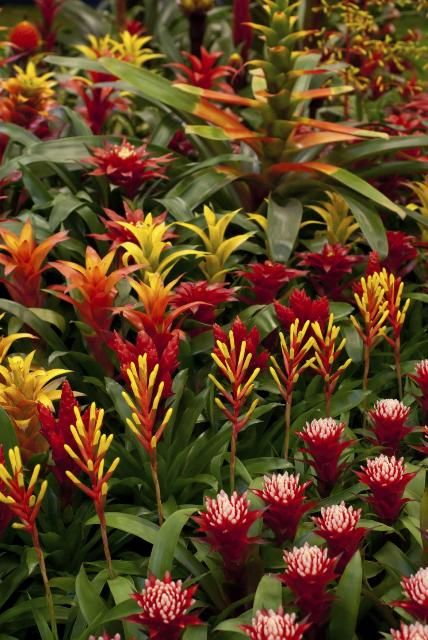
Credit: Florelena/iStock/Thinkstock, © Florelena
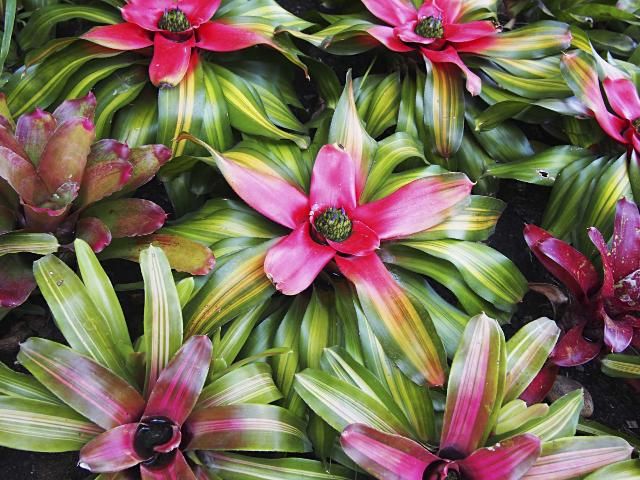
Credit: Ratana21/iStock/Thinkstock, © Ratana21
Bromeliads as Houseplants
Bromeliads make excellent houseplants (Figure 3) that will survive (but not grow) for many weeks under very low light conditions. They'll thrive on a porch, near a window, or anywhere where they receive bright, diffused light, but no direct sun. A bromeliad will indicate whether light levels are satisfactory. A yellowish or pale green plant may indicate that the light level is too high. Conversely, dark green, soft, drooping leaves may be signs that light is too low. Water once every week or two. The simplest way is to put the plant in the sink or shower and allow lukewarm water to fill the cup and run over the leaves and into the soil; then drain the cup. It is rarely necessary to fertilize bromeliads kept as houseplants.
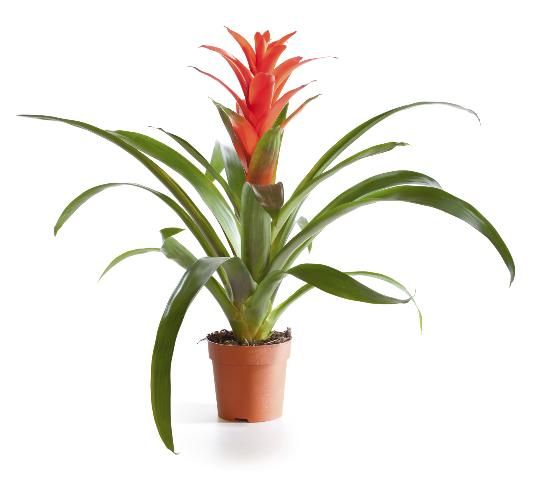
Credit: Andrew_Mayovskyy/iStock/Thinkstock, © Andrew_Mayovskyy
Bromeliads as Landscape or Container Plants
Most bromeliads are tropical or subtropical and thrive outdoors in Florida's warm, humid environment (Figure 4). In north Florida, grow them in containers and move them indoors during freeze or frost events. Most prefer shade or partial shade, but some tolerate full sun. Even though they prefer moisture and humidity, they are extremely tolerant of low-moisture conditions and will survive prolonged periods of drought. Most problems with bromeliads are associated with root rot caused by too much moisture. The sandy, well-drained soils found throughout most of Florida soils are suitable for growing bromeliads. Where heavy clay soils exist, amend them with 2 to 3 inches of organic matter (peat, leaf mold, compost, etc.) mixed into the planting bed. Potted plants need a light, porous potting mix.
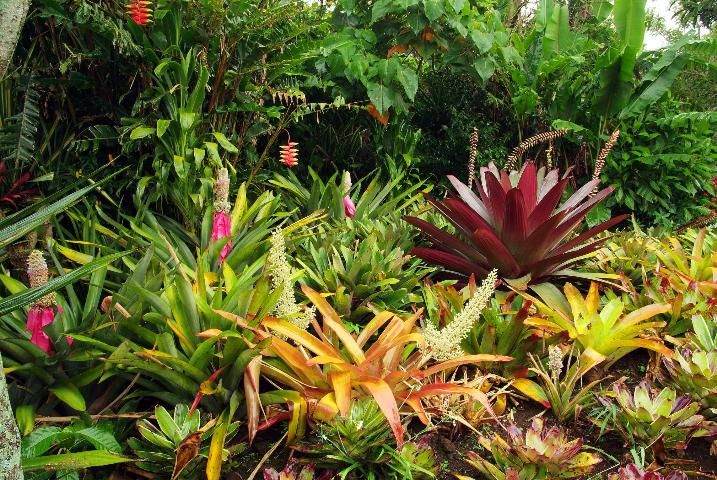
Credit: Patrick Kennedy/Hemera/Thinkstock, © Patrick Kennedy
Many bromeliads form a "cup" or "vase" in their centers which holds and absorbs water. Occasionally flush the cup with water to prevent stagnation and to remove the salts left when water in the cup evaporates. To prevent cold damage, remove water from the cup when temperatures below 40°F are likely. Cold damage appears as a brown line across each leaf at the water level.
Actively growing bromeliads respond to light applications of fertilizer. They require little or no fertilizer during the winter months, or under conditions of low light such as inside a home or office. A general-purpose, soluble fertilizer can be applied to the soil of potted bromeliads every 1 to 2 months. Mix the fertilizer in water at 1/3 to ½ of the recommended dosage. It is best not to add fertilizer in the center cup because fertilizer salts could accumulate and burn new leaves.
You can grow some bromeliads on a board or piece of bark. Use staples, various glues, plastic-coated wire, or nylon stockings to attach them. Bromeliads can also be attached to the trunks of trees using glue and stockings to hold them in place until their roots attach securely to the tree trunk. Douse them with water when humidity or rainfall is low.
Blooming and Propagation
Bromeliads slowly die a year or two after flowering. However, pups (young plants) usually develop at the base of the "mother" plant. Separate the pups from the mother plant when they are half the size of the parent plant. To start new plants, simply cut the pup off where it attaches to the mother plant and place it in potting soil (Figure 5). Many factors affect blooming—plant age, day length, light intensity, water, and temperature. Some bromeliads bloom quite regularly while others do not. Bromeliad plants must be mature to flower. The time from the formation of a pup to maturity is approximately one year, but some species take much longer. The foliage of most bromeliads is typically so interesting and/or colorful that the blooms are considered a bonus.
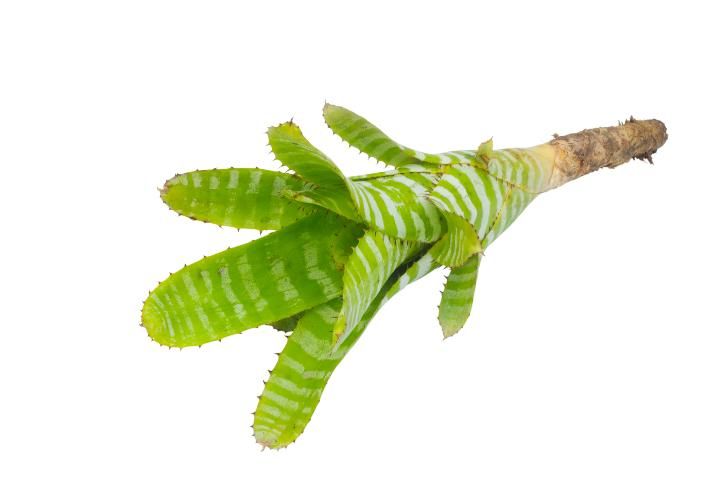
Credit: kamnuan/iStock/Thinkstock, © kamnuan
Pests
Mosquitoes will breed in the water-filled cups of bromeliads growing outdoors. Once a week during the summer and fall rainy season, use a garden hose to flush out mosquito larvae and decaying leaves and twigs, which are a food source to the larvae. A biological mosquito control product (Bacillus thuringiensis subspecies israelensis) is available from garden centers, home supply stores, and online. The product should be sprinkled into bromeliad cups every 2–3 weeks in summer and fall; it will kill some species of mosquito larvae in 24 hours. For more information on reducing mosquitoes around your home, refer to UF/IFAS publications available online: https://gardeningsolutions.ifas.ufl.edu/care/pests-and-diseases/pests/mosquitoes and Mosquitoes & Their Control which can be purchased from the UF/IFAS Extension Bookstore (http://ifasbooks.ifas.ufl.edu/p-1273-mosquitoes-their-control.aspx).
The Mexican bromeliad weevil, Metamasius callizona, attacks native bromeliads, especially Tillandsia, but has been known to damage private and commercial collections as well. The adult weevils feed on the leaves and flower stalks, leaving unsightly marks (Figure 6). The larvae are more destructive, tunneling into the base of the plant, and separating the leaves from the roots. Symptoms include leaves that are browning or decomposing near the base, and sections of the plant falling away, resulting in the death of the plant. Some plants exude a clear, gelatin-like substance thought to be used in defense. For more information on the "evil weevil," see Featured Creatures at http://entomology.ifas.ufl.edu/creatures/orn/m_callizona.htm.
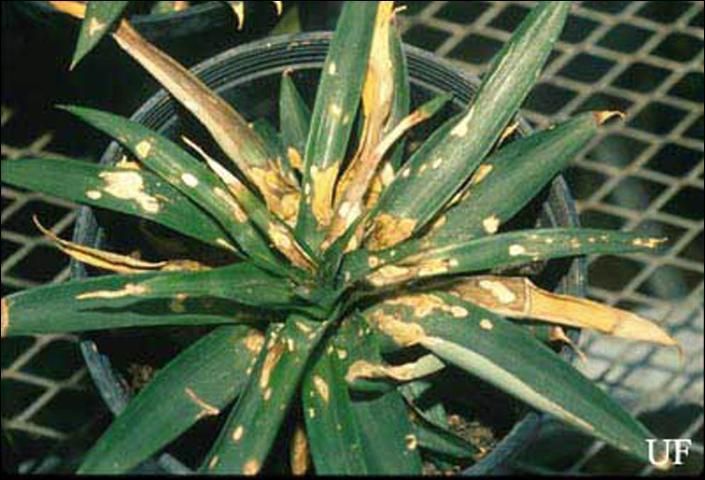
Credit: P. M. Choate, University of Florida
Although the bromeliad is a fairly pest-free plant, scale and mealybug insects can sometimes be a problem. Your UF/IFAS Extension office can provide safe and effective management information: https://sfyl.ifas.ufl.edu/find-your-local-office/.
References
Bromeliad Culture Brochure. https://www.bsi.org/members/pdf/BSI%20Bromiliad%20Culture%20Brochure.pdf
Bromeliad International Society. http://www.bsi.org/new/
Florida Council of Bromeliad Societies: http://fcbs.org/members.htm
Frank, J.H. Bromeliad-inhabiting mosquitoes in Florida: http://entnemdept.ufl.edu/frank/bromeliadbiota/mosbrom.htm